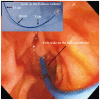Clin Endosc.
2013 Mar;46(2):201-202. 10.5946/ce.2013.46.2.201.
Balloon Catheter Assisted Biliary Stent Insertion
- Affiliations
-
- 1Digestive Disease Center, CHA Bundang Medical Center, CHA University, Seongnam, Korea. bluehipp@cha.ac.kr
- KMID: 1805307
- DOI: http://doi.org/10.5946/ce.2013.46.2.201
Abstract
- No abstract available.
Figure
Reference
-
1. Speer AG, Cotton PB, Russell RC, et al. Randomised trial of endoscopic versus percutaneous stent insertion in malignant obstructive jaundice. Lancet. 1987; 2:57–62. PMID: 2439854.
Article2. Cowling MG, Adam AN. Internal stenting in malignant biliary obstruction. World J Surg. 2001; 25:355–359. PMID: 11343193.
- Full Text Links
- Actions
-
Cited
- CITED
-
- Close
- Share
- Similar articles
-
- The Clinical Efficacy of Uisng a Soehendra Stent Retriever for Endoscopic Biliary Drainage in Malignant Biliary Obstruction
- Three Cases of Biliary Drainage in High Grade Malignant Biliary Stricture Using Soehendra Stent Retriever
- Combined use of a two-channel endoscope and a flexible tip catheter for difficult biliary cannulation
- Percutaneous Biliary Metallic Stent Insertion in Patients with Malignant Duodenobiliary Obstruction: Outcomes and Factors Influencing Biliary Stent Patency
- Placement of an Implantable Port Catheter in the Biliary Stent: An Experimental Study in Dogs



